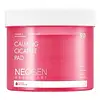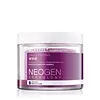What's inside
What's inside
 Key Ingredients
Key Ingredients

 Benefits
Benefits

 Concerns
Concerns

 Ingredients Side-by-side
Ingredients Side-by-side

Water
Skin ConditioningButylene Glycol
HumectantGlycerin
HumectantDipropylene Glycol
Humectant1,2-Hexanediol
Skin ConditioningCentella Asiatica Extract
CleansingBetaine
HumectantCetearyl Olivate
Sorbitan Olivate
EmulsifyingPanthenol
Skin ConditioningGluconolactone
Skin ConditioningGlyceryl Caprylate
EmollientTromethamine
BufferingEthylhexylglycerin
Skin ConditioningAcrylates/C10-30 Alkyl Acrylate Crosspolymer
Emulsion StabilisingXanthan Gum
EmulsifyingCitrus Aurantium Bergamia Fruit Oil
MaskingAllantoin
Skin ConditioningAsiaticoside
AntioxidantMadecassic Acid
Skin ConditioningAsiatic Acid
Skin ConditioningGuaiazulene
AntimicrobialNiacinamide
SmoothingAdenosine
Skin ConditioningMelaleuca Alternifolia Leaf Oil
AntioxidantZinc PCA
HumectantCapryloyl Salicylic Acid
ExfoliatingHouttuynia Cordata Extract
Skin ConditioningCaprylic/Capric Triglyceride
MaskingAdansonia Digitata Seed Oil
EmollientHydrogenated Lecithin
EmulsifyingCeramide NP
Skin ConditioningSodium Hyaluronate
HumectantPortulaca Oleracea Extract
Skin ConditioningSaururus Chinensis Extract
Skin ConditioningPropolis Extract
Skin ConditioningCaprylyl Glycol
EmollientTocopheryl Acetate
AntioxidantHydroxypropyltrimonium Hyaluronate
Madecassoside
AntioxidantAloe Barbadensis Leaf Extract
EmollientAcorus Calamus Root Extract
PerfumingPentylene Glycol
Skin ConditioningCeramide Ns
Skin ConditioningCeramide As
Skin ConditioningCeramide EOP
Skin ConditioningCeramide AP
Skin ConditioningGlucose
HumectantHydrolyzed Hyaluronic Acid
HumectantSodium Acetylated Hyaluronate
HumectantHyaluronic Acid
HumectantChondrus Crispus Extract
Skin ConditioningMelaleuca Alternifolia Leaf Extract
PerfumingSodium Hyaluronate Crosspolymer
HumectantHydrolyzed Sodium Hyaluronate
Skin ConditioningPotassium Hyaluronate
Skin ConditioningLimonene
PerfumingLinalool
PerfumingWater, Butylene Glycol, Glycerin, Dipropylene Glycol, 1,2-Hexanediol, Centella Asiatica Extract, Betaine, Cetearyl Olivate, Sorbitan Olivate, Panthenol, Gluconolactone, Glyceryl Caprylate, Tromethamine, Ethylhexylglycerin, Acrylates/C10-30 Alkyl Acrylate Crosspolymer, Xanthan Gum, Citrus Aurantium Bergamia Fruit Oil, Allantoin, Asiaticoside, Madecassic Acid, Asiatic Acid, Guaiazulene, Niacinamide, Adenosine, Melaleuca Alternifolia Leaf Oil, Zinc PCA, Capryloyl Salicylic Acid, Houttuynia Cordata Extract, Caprylic/Capric Triglyceride, Adansonia Digitata Seed Oil, Hydrogenated Lecithin, Ceramide NP, Sodium Hyaluronate, Portulaca Oleracea Extract, Saururus Chinensis Extract, Propolis Extract, Caprylyl Glycol, Tocopheryl Acetate, Hydroxypropyltrimonium Hyaluronate, Madecassoside, Aloe Barbadensis Leaf Extract, Acorus Calamus Root Extract, Pentylene Glycol, Ceramide Ns, Ceramide As, Ceramide EOP, Ceramide AP, Glucose, Hydrolyzed Hyaluronic Acid, Sodium Acetylated Hyaluronate, Hyaluronic Acid, Chondrus Crispus Extract, Melaleuca Alternifolia Leaf Extract, Sodium Hyaluronate Crosspolymer, Hydrolyzed Sodium Hyaluronate, Potassium Hyaluronate, Limonene, Linalool
Water
Skin ConditioningButylene Glycol
HumectantGlycerin
HumectantAlcohol Denat.
AntimicrobialPEG/PPG-17/6 Copolymer
SolventWine Extract
AntioxidantSodium Hyaluronate
HumectantResveratrol
AntioxidantCarbomer
Emulsion StabilisingVitis Vinifera Seed Extract
AntimicrobialRubus Fruticosus Fruit Extract
AstringentRubus Idaeus Fruit Extract
AstringentVaccinium Angustifolium Fruit Extract
Skin ProtectingCoptis Japonica Extract
AntimicrobialTartaric Acid
BufferingGlycolic Acid
BufferingLactic Acid
BufferingTromethamine
BufferingCI 19140
Cosmetic ColorantCI 17200
Cosmetic ColorantCI 42090
Cosmetic ColorantBenzophenone-5
UV AbsorberDisodium EDTA
Phenoxyethanol
PreservativeEthylhexylglycerin
Skin ConditioningPEG-60 Hydrogenated Castor Oil
Emulsifying1,2-Hexanediol
Skin ConditioningParfum
MaskingWater, Butylene Glycol, Glycerin, Alcohol Denat., PEG/PPG-17/6 Copolymer, Wine Extract, Sodium Hyaluronate, Resveratrol, Carbomer, Vitis Vinifera Seed Extract, Rubus Fruticosus Fruit Extract, Rubus Idaeus Fruit Extract, Vaccinium Angustifolium Fruit Extract, Coptis Japonica Extract, Tartaric Acid, Glycolic Acid, Lactic Acid, Tromethamine, CI 19140, CI 17200, CI 42090, Benzophenone-5, Disodium EDTA, Phenoxyethanol, Ethylhexylglycerin, PEG-60 Hydrogenated Castor Oil, 1,2-Hexanediol, Parfum
Ingredients Explained
These ingredients are found in both products.
Ingredients higher up in an ingredient list are typically present in a larger amount.
1,2-Hexanediol is a synthetic liquid and another multi-functional powerhouse.
It is a:
- Humectant, drawing moisture into the skin
- Emollient, helping to soften skin
- Solvent, dispersing and stabilizing formulas
- Preservative booster, enhancing the antimicrobial activity of other preservatives
Butylene Glycol (or BG) is used within cosmetic products for a few different reasons:
Overall, Butylene Glycol is a safe and well-rounded ingredient that works well with other ingredients.
Though this ingredient works well with most skin types, some people with sensitive skin may experience a reaction such as allergic rashes, closed comedones, or itchiness.
Learn more about Butylene GlycolEthylhexylglycerin (we can't pronounce this either) is commonly used as a preservative and skin softener. It is derived from glyceryl.
You might see Ethylhexylglycerin often paired with other preservatives such as phenoxyethanol. Ethylhexylglycerin has been found to increase the effectiveness of these other preservatives.
Glycerin is already naturally found in your skin. It helps moisturize and protect your skin.
A study from 2016 found glycerin to be more effective as a humectant than AHAs and hyaluronic acid.
As a humectant, it helps the skin stay hydrated by pulling moisture to your skin. The low molecular weight of glycerin allows it to pull moisture into the deeper layers of your skin.
Hydrated skin improves your skin barrier; Your skin barrier helps protect against irritants and bacteria.
Glycerin has also been found to have antimicrobial and antiviral properties. Due to these properties, glycerin is often used in wound and burn treatments.
In cosmetics, glycerin is usually derived from plants such as soybean or palm. However, it can also be sourced from animals, such as tallow or animal fat.
This ingredient is organic, colorless, odorless, and non-toxic.
Glycerin is the name for this ingredient in American English. British English uses Glycerol/Glycerine.
Learn more about GlycerinSodium Hyaluronate is hyaluronic acid's salt form. It is commonly derived from the sodium salt of hyaluronic acid.
Like hyaluronic acid, it is great at holding water and acts as a humectant. This makes it a great skin hydrating ingredient.
Sodium Hyaluronate is naturally occurring in our bodies and is mostly found in eye fluid and joints.
These are some other common types of Hyaluronic Acid:
Learn more about Sodium HyaluronateTromethamine helps balance the pH and improve the texture of a product. It is synthetically created.
As an emulsifier, Tromethamine prevents oil and water ingredients from separating. This helps stabilize the product and elongate a product's shelf life. Tromethamine also makes a product thicker.
Tromethamine helps balance the pH level of a product. Normal pH level of skin is slightly acidic (~4.75-5.5). The acidity of our skin is maintained by our glands and skin biome. Being slightly acidic allows our skin to create an "acid mantle". This acid mantle is a thin barrier that protects our skin from bacteria and contaminants.
Oral Tromethanmine is an anti-inflammatory drug but plays the role of masking, adding fragrance, and/or balancing pH in skincare.
1,3-Propanediol, 2-amino-2-(hydroxymethyl)-
Learn more about TromethamineWater. It's the most common cosmetic ingredient of all. You'll usually see it at the top of ingredient lists, meaning that it makes up the largest part of the product.
So why is it so popular? Water most often acts as a solvent - this means that it helps dissolve other ingredients into the formulation.
You'll also recognize water as that liquid we all need to stay alive. If you see this, drink a glass of water. Stay hydrated!
Learn more about Water